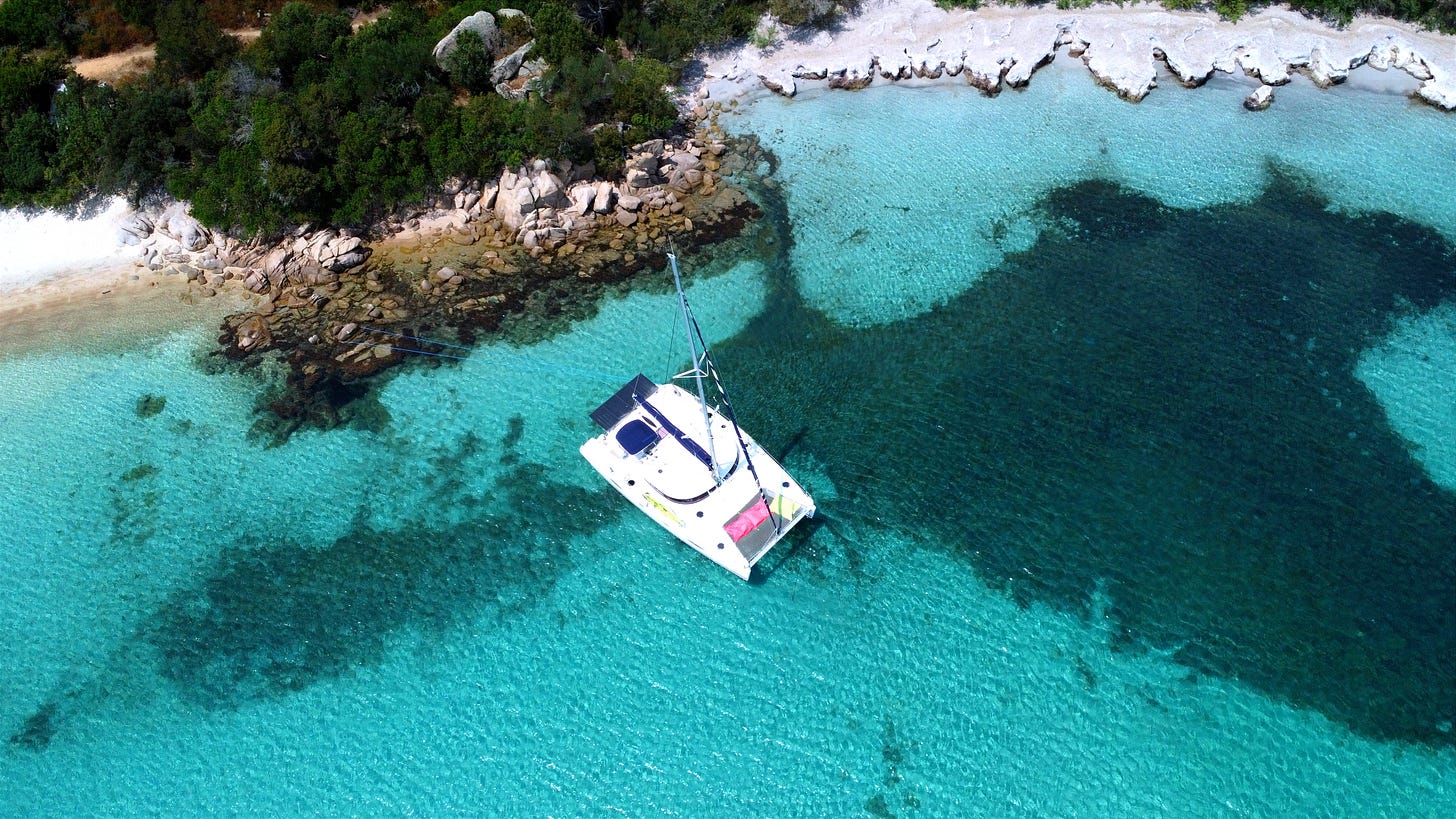MULTIpedia #06 - 2025.06.13
THE 100% MULTIHULL NEWSLETTER
In this issue, MULTIpedia reveals Christophe Barreau's new personal catamaran, the future Energy Observer, a new Jeff Schionning design, details of the construction of the Ultim Gitana 18…and much more!
LIGHT IS RIGHT
As talented as he is iconoclastic, naval architect Christophe Barreau has always designed something 'different', whether for Catana, Outremer, TS, or Windelo. For him, a multihull must above all be light, efficient, and elegant. “Perfection is achieved, not when there is nothing more to add, but when there is nothing left to take away,” said writer and aviator Antoine de Saint-Exupery. So, bucking market trends but very much in tune with the times, Christophe designed and built a slick catamaran for his own use, the Bivouac. For the first time, he reveals its lines and explains the concept in this interview.
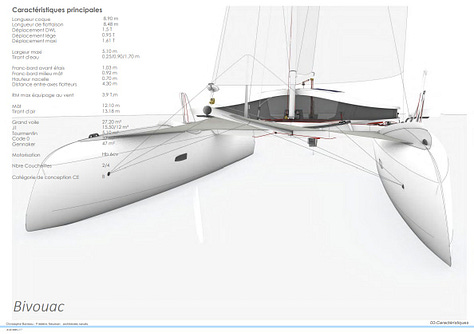
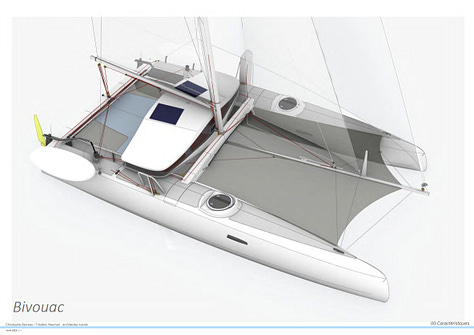
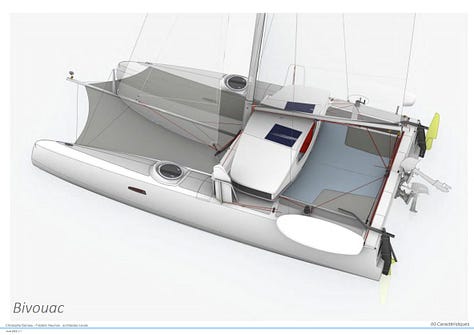
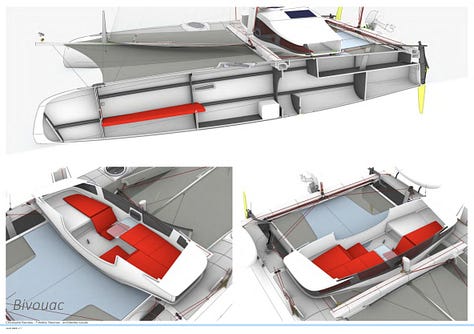
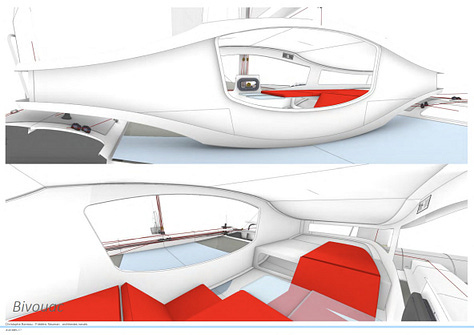
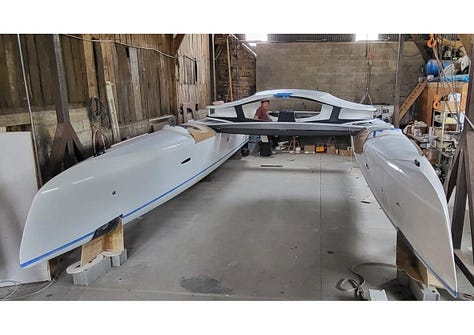
Click on the pictures or HERE to enlarge.
How did the Bivouac project come about?
It started out as a personal project. A few years ago, I made two trips to Spitzbergen with my partner, which made a big impression on me. The first time was in 1988 with our Catana 40, which we partly built, a super-light but fairly comfortable boat that was even heated. She was called Diabolo, she still exists and she has been around the world several times since then. We sailed the boat from France up to 81° North, sailing through the ice pack! At the time, we were paragliding fans, so we did it all over the place, in Scotland, Norway... But we were a little disappointed that we couldn't enjoy these incredible places more, where at the time we were all alone. We felt a bit removed from nature, the way it felt, the smells, the sounds, the lights that we didn't always see because on board a boat we're sometimes less observant. So, the following year we sent a Hobie Cat 18 Formula and sailed up there for 5 weeks, and we loved it. During the first trip we were often bothered by the fact that we couldn't leave the boat at anchor, because there was no shelter or there was ice. With the Hobie, on the other hand, my partner, she is a mountaineer, and I, could haul it onto the beach, and we were free to walk around as we liked, go cross-country skiing or whatever. With that in mind, in 2018 I designed the TS3, which is light (2 tons), with a draught of 30 cm / 1 ft... but 11 m / 36’ nonetheless. So, the idea is to have a boat that's a little more comfortable than a Hobie, but not complicated to leave somewhere, to go into a small lagoon, a river or even to haul it ashore, and so to have a certain independence from the boat so that you can do something other than boating when you get to interesting places.
What can you tell us about this catamaran?
The boat is 8.90 m (29 feet) long and 5.10 m (16.76 ft) wide. The UFO-style nacelle contains two small double berths. You can sleep 4 people, but ideally 2, thus there's plenty of storage space. The nacelle weighs 70 kg, and the ceiling in the central section is a 8/10ths aviation plywood, not even 1 mm thick. You can sail with or without it, as the net passes underneath. It measures 1.35 m/ 4.43 ft lengthways, almost 4.20 m / 13.78 ft wide and 1 m / 3.28 ft at its highest point. You can sit in it, it's very glazed, very bright, not yet very ventilated, but we're going to work on that. In the floats, it's possible to put bunks in front, which are more spacious than we imagined, or a toilet to make the boat a little more 'comfortable'. Access is forward of the central arm, protected by a breakwater, with 60 cm / 2 ft hatches allowing folding bikes to be stored. Behind the nacelle is a cockpit recessed into the floats, so you're not sitting cross-legged but with your feet down. And there will be wings on the sides, like our famous Hobie Cat, but these are paddles. When you're sitting on them, you can see the boat moving across the water, going through the waves, like an outside view. What's more, you get to take part in the righting moment, which gives it a bit more power. She should weigh 800kg lightship, but the waterline visible on the drawings is 1,500kg, which means she has almost as much payload as lightship weight, should we ever use her in expedition mode. I financed the moulds for the hull, nacelle, arms and appendages. The hulls are made in two parts, with half-bulkheads in the half-hulls, which are then glued together. It was made from PVC and basalt fibre and the bottom of the hull was made from Innegra, a polyethylene carbon, to make it virtually untearable.
And the nacelle is suspended?
Yes, in fact, this boat's architectural concept is in line with Marc Guillemot's MG5. It's exactly the same principle: two hulls, two arms and a nacelle that sits on silent blocks. The advantage of this system is that you hear much less of the boat's noise, and the living space is quieter. And as the nacelle is not structural, it can be glazed a lot. You take the boat apart, put it on its cradles on a car tray, and take it wherever you want. We'll reassemble it next Friday and launch it in the evening. The most time-consuming part will be re-tensioning the trampoline, as we've never done it before, and masting. We've got a bowsprit to which the forestay returns, and no crossbeam in front. So, the mast and trampoline depend on this spar.
What is the planned navigation program?
The idea is firstly to test her abilities, and then my own, because in the meantime I've aged quite a bit (laughs)! I'm going to take her back home to North Brittany in July, and then if the boat's doing well, we might go for a trip to the Scilly Islands. Eventually, in the back of my mind, my dream is still to sail up the east coast of Greenland. But I'll see if I feel up to it or if we go for a more relaxed program.
SPOTTED
Arbitru cove in southeastern Corsica. Thank you to Marie-Ange and Thomas, owners of the Salina 48 Shamane, and to their crew, for allowing us to discover this magnificent place just before the season.
IN BRIEF
PLAN
Renowned Australian designer Jeff Schionning has just unveiled the design of the ARROW 980. This compact catamaran has a hull length of 9.80 m (32 ft), an overall length of 10.27 m (33.7 ft), a displacement of just 4,000 kg, and a sail area of 55.8 sqm upwind and 119 sqm downwind. As with all its multihulls, Schionning Designs International offers the Arrow 980 as a kit, making it easier for private builders, more economical and fully customizable.
UNDER WAY
Multiplast (Vannes - France) launched the composite platform of the CODE C.69 catamaran on June 12, built for Black Pepper Yachts. The boat will be towed to Nantes (France) for the interior fittings, deck fittings and all finishing work.
BETTER
Five models in the Lagoon range are now manufactured with “low carbon” resin made from 45% bio-based and recycled materials, i.e. renewable organic matter (biomass) of plant or animal origin produced by Polynt.
ASIA
Is this a sign that the Asian market is maturing, or that the European and American markets are struggling? In any case, catamaran manufacturers Aquila (motor) and Bali (sail and motor) have both announced the appointment of new representatives in this region. For the former Europa Yachts in Indonesia and Tam Son Yachting in Vietnam, while for the latter Fairview Yachting in Thailand and Hong Kong.
FUTURE
Ten years after the launch of Energy Observer 1 (formerly Mike Birch's Formula Tag racing catamaran), which has already sailed 68,000 nautical miles without fossil fuels, Energy Observer announced at UNOC#03 in Nice that a new expedition catamaran (EO3) will be launched in 2027. This new-generation multihull combines several complementary energy sources:
● A low-carbon fuel: ammonia, a hydrogen carrier
● Electric propulsion powered by low- and high-temperature batteries and fuel cells
● Solar panels
● Four sailing wings, contributing to propulsion and autonomy.
MARKET
In an interview with the website boursier.com (in French), David Etien, Chief Financial Officer of Catana Group (Bali, Catana, YOT), revealed that professional charter accounts for more than 50% of the group's market. To date, “The order book is good for large vessels (...), but significantly weaker for small and medium-sized boats.” The group's strategy in the current context is to “have a regularly renewed fleet (and) expand our range to other promising market segments (power boats, large vessels)”.
HIGHS AND LOWS
Outremer celebrated the launch of the 100th Outremer 45 in Lorient, a production volume rarely achieved in the French shipyard's niche market. Unfortunately, at the same time, the Outremer 45 Lula Bay collided violently with an unidentified floating object 70 nautical miles southwest of the island of Ua Pou (Marquesas Islands, Pacific). With water rapidly flooding the port side of the hull, former Olympic champion Charline Picon and her family activated their EPIRB and were rescued, incredible coincidence, by another Outremer 45 sailing in the area. As the multihull's buoyancy was still assured, the shipyard is attempting to locate and bring the damaged catamaran back to shore.
RALLY
The Bali Catamarans shipyard has renewed its partnership with the Rallye des Iles du Soleil organized by GPO, which will depart from Fuerteventura in the Canary Islands on October 31st, bound for Marie-Galante in Guadeloupe via Mindelo in Cape Verde.
HERITAGE
The former Umupro Jardin V, winner of the OSTAR in 1984 with Yvon Fauconnier, has been relaunched in South America after four years of repairs following a violent grounding. (Info thanks to Anthony Morisseau on Facebook).
RACING
ULTIM
After announcing a multi-year vision for its racing calendar (see MULTIpedia #05), the Ultim class announced two new developments. The 24h Ultim (Lorient on September 25) will be open to Ocean Fifty class trimarans, and a new race, the Odyssee Ultim, will be a round trip between Antibes (France) and Olympe in Greece (starting on April 29, 2026). Five trimarans are currently being considered, pending the sale of the former Actual trimaran to a potential sixth team.
NDA
The second episode dedicated to the top-secret construction of the new ULTIM Gitana 18 trimaran is now on YouTube (English subtitles available). We learn, among other things, that the 32-meter-long (105 ft) central hull was built in three parts, using the autoclave at the CDK shipyard, which, although one of the largest available, is “only” 24 meters (78’) long and 4 meters (13 ft) in diameter. According to Stéphane Digard, CEO of CDK Technologies, the construction required 200,000 hours of work spread over 20 months, employing an average of 45 people. It took 30 molds to manufacture the pieces of the puzzle. The most attentive viewers will have noticed this plan displayed on the board, where we can make out a lowered cockpit positioned in the traditional position in front of the rear arm. It can be estimated that it is located halfway between the previous Gitana 17, which was at deck level, and that of SVR-Lazartigue, which was so low that its compliance with the rules was questioned by its opponents due to lack of visibility.
NEW CALEDONIA
The New Caledonia Groupama Race sets sail this Sunday, June 15, from Nouméa for a 654-nautical-mile race around the world's largest lagoon. The catamarans Roamance (14m/47') and Rushour (15m/50') have come from Australia to challenge Kalolo, the local Looping 56. The real-time victory should not escape one of these three multihulls.
Got some info, a question, a comment?
If you liked it, do not hesitate to share with your friends, colleagues, customers, or suppliers.
If this email has been forwarded to you,
you can subscribe for free to receive our new articles directly.
Thanks for reading MULTIpedia!


